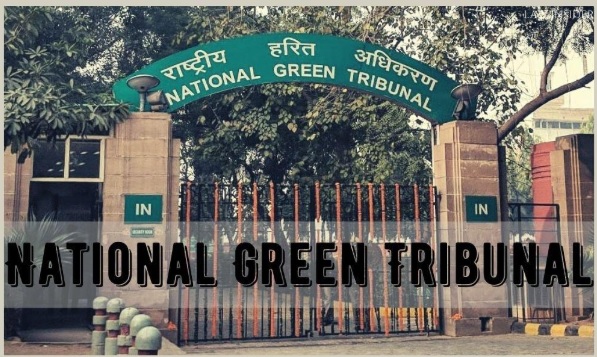- It is a special judicial body established for the expeditious resolution of environmental protection and natural resource conservation matters.
- The NGT acts as a vital institution in India to ensure environmental protection and sustainable development.

Establishment of NGT
- Established: 18th October 2010
- Under the National Green Tribunal Act, 2010
- Headquarters: New Delhi
- Other Benches: Bhopal, Pune, Kolkata, and Chennai
- India became the third country in the world (and the first among developing nations) to establish such a tribunal. Previously, only Australia and New Zealand had similar tribunals.
Objectives and Functions of NGT:
The NGT is mandated to resolve environmental disputes within 6 months. Its core functions include:
- Hearing and resolving environmental issues.
- Ensuring the protection of forests and natural resources.
- Enforcing the “Polluter Pays” and “Precautionary Principle”.
- Resolving disputes related to Environmental Clearances.
- Controlling issues such as river pollution, waste management, air pollution, and other environmental problems.
Structure, Qualifications, Appointment, and Tenure of NGT Members
Members of NGT:
As per the National Green Tribunal Act, 2010, the NGT comprises the following types of members:
Chairperson : Acts as the head of the tribunal.
Judicial Members : Minimum: 10; Maximum: 20 (The exact number is notified by the Central Government).
Expert Members : Minimum: 10; Maximum: 20 (Also notified by the Government).
Part-time Members : The Chairperson may invite individuals with specialized knowledge and experience on a part-time basis to assist in particular cases.
Qualifications of NGT Members:
Chairperson
Must be a judge of the Supreme Court or Chief Justice of a High Court.
Judicial Members
Must have served as:
- A judge of the Supreme Court, or
- Chief Justice or judge (serving or retired) of a High Court.
Expert Members
Must have:
- A degree in Technology,
- At least 5 years of practical experience in the field of environment or forests at a national-level institution, and
- A total of 15 years of experience in the relevant field or in working with Central/State Governments.
Appointment of NGT Members:
Chairperson: Appointed by the Central Government in consultation with the Chief Justice of India (CJI).
Judicial and Expert Members: Appointed through a Selection Committee constituted by the Central Government.
Tenure of Members:
- Tenure: Maximum of 5 years or until 65 years of age, whichever is earlier?
- Reappointment: Not allowed for Chairperson, Judicial, and Expert Members.
Powers and Jurisdiction of NGT:
Decision-Making in Environmental Matters:
- Has jurisdiction over civil cases related to the environment?
- In October 2021, the Supreme Court granted NGT the power of suo motu (taking cognizance on its own).
Appellate Jurisdiction:
- Appeals against NGT decisions can only be filed in the Supreme Court of India.
- Appeals must be made within 90 days of the tribunal’s order.
Penalties and Punishments:
- If any individual violates NGT regulations:
- Imprisonment up to 3 years
- Fine up to ₹10 crore
- Or both
Key Environmental Laws under NGT's Jurisdiction:
NGT can hear matters under the following Acts:
- Water (Prevention and Control of Pollution) Act, 1974
- Forest (Conservation) Act, 1980
- Air (Prevention and Control of Pollution) Act, 1981
- Environment (Protection) Act, 1986
- Biological Diversity Act, 2002
However, NGT has no jurisdiction over cases under:
- The Wildlife (Protection) Act, 1972
- The Forest Rights Act, 2006
Significance of NGT
- Provides an effective platform for timely resolution of environmental cases.
- Reduces burden on High Courts.
- Offers a low-cost and faster legal process for environmental disputes.
- Compels industries and governments to comply with environmental norms.
Challenges Faced by NGT
- Limited jurisdiction – Cannot hear cases related to wildlife and forest rights.
- Legal ambiguities – Its decisions are often challenged in higher courts.
- Institutional weaknesses – Shortage of judicial and expert members hampers its functioning.
- Implementation issues – Government departments often fail to execute NGT orders effectively.
Landmark Judgments by NGT
Almitra Patel v. Union of India (2012)
Verdict: Banned open burning of garbage.
Impact: Led to stricter solid waste management regulations.
Srinagar Dam Disaster Case (2013)
Verdict: Ordered hydro power company to pay compensation.
Impact: Enforced “Polluter Pays” principle.
Save Mon Federation Case (2013)
Verdict: Suspended ₹6,400 crore hydropower project to protect bird habitats.
Ban on Diesel Vehicles in Delhi-NCR (2015)
Verdict: Banned diesel vehicles older than 10 years.
Impact: Helped curb air pollution.
Plastic Ban (2017)
- Verdict: Prohibited plastic bags with thickness below 50 microns.
- Impact: Step toward controlling plastic pollution.
- N.G. Soman v. Bharat Petroleum (2022)
- Verdict: Imposed ₹2 crore fine for greenbelt violation.
- Impact: Emphasized adherence to environmental norms in industrial zones.
Way Forward
- Expand NGT's jurisdiction to include wildlife and forest rights issues.
- Appoint more judicial and expert members to fill vacancies.
- Enact stronger mechanisms to ensure implementation of NGT’s orders.
